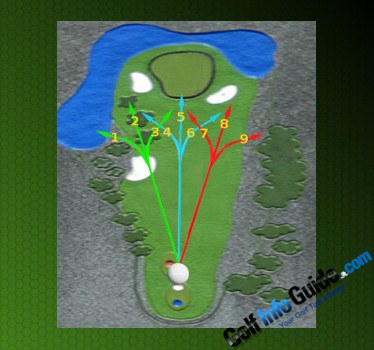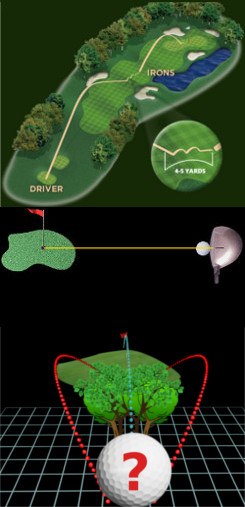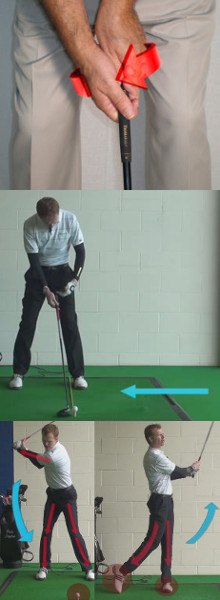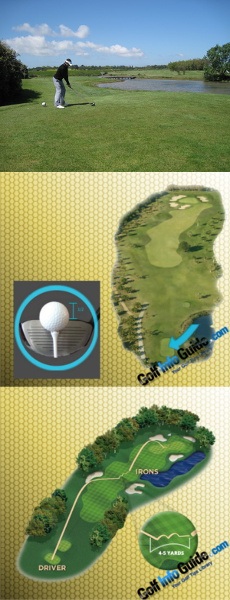Wouldn’t golf be easy if you could hit your drives perfectly straight, time after time?

Okay, so it might not be easy, per se, but it sure would be a lot easier. This is a hard game, and much of the challenge comes from the fact that the ball curves as it flies through the air. Hitting your drives straight would be a major advantage, as you would be able to hit a high percentage of fairways and keep your ball out of trouble more often than not.
Unfortunately, we have some bad news – you are never going to hit the ball completely straight off the tee, time after time. It just isn’t possible. Due to the dynamics of this game, the ball is naturally going to curve, at least a little bit. And that’s okay. The key isn’t necessarily to stop the ball from curving, but rather to be able to control and predict that curve successfully. As long as you know which way the ball is going to curve, and how much, you can plan accordingly and produce quality shots that keep you moving forward.
The focus of this article is to provide you with tips on how to control the curve of your drives as they fly down the fairway. Of course, as any experienced golfer knows, this is a task which is much easier said than done. Controlling the golf ball is a major challenge with any of your clubs, and that challenge is even greater when hitting long clubs from the tee, like your driver or fairway woods. At the moment, you may be dealing with a nasty slice, or some other shot shape that makes it difficult for you to reach your goals on the links. If that is the case, don’t give up hope. By putting in some hard work during practice, and by focusing on the right things during those practice sessions, you may be able to gain control over your drives sooner than you think.
All of the content below has been written from the perspective of a right-handed golfer. If you happen to play left-handed, please take a moment to reverse the directions as necessary.
Three Basic Problems Related to Curving Drives

You are inevitably going to run into trouble on the golf course when your drives curve dramatically in one direction or the other. If you aren’t sure that this is actually a problem, just take a look at the golf you see the professionals playing on TV as proof. Do those players hit shots that curve wildly from one side of the hole to the other? Rarely. More often than not, they are playing shots which travel relatively straight, while turning just a bit to the right or left as they fly. This is the kind of shot you should strive to master if you would like to take a step forward in your game.
So, what is so troublesome about curving your tee shots significantly to the right or left? Let’s take a look at the three main problems.
- Difficulty hitting the fairway. This one probably goes without saying, but it is going to be quite hard to consistently hit fairways when the ball is hooking or slicing as it flies. Of course, that is not to say that it will be impossible to hit fairways – you may be able to judge your curve just right from time to time, allowing the ball to come to rest on the short grass. That should not have to be your plan on every tee shot, however, as consistency will be nearly impossible to achieve. Golf is a much more manageable game when played from the fairway, and you should be able to find quite a few more fairways if you can straighten out your ball flight in the near future.
- Loss of distance. No one likes to give up distance unnecessarily in this game. Most golfers work hard for every single yard they are able to produce, so it would be a shame to give some of those yards away just because your tee shots are curving too much. When the ball curves, some of the energy that could have been used to take it farther down the fairway is being used to move it from side to side. That’s simply a waste, and it is going to mean a shorter overall drive when the ball comes to rest. The curve is not particularly harmful when it is a fade or draw of just a few yards, but it can rob you of significant distance when we are talking about a full-fledged hook or slice. For many golfers, the path toward longer drives doesn’t actually go through improved swing speed at all. Rather, the average golfer will be able to find longer drives simply by hitting straighter shots.
- Dealing with obstacles. As you know, golf courses are generally not constructed with perfectly straight fairways on flat ground. Usually, courses feature some degree of undulation within the property, and the fairways often turn from side to side to add interest and challenge. Also, depending on where you play golf, there may be trees that stand in the way of where you would like to send the ball. All that is to say you might not be able to use your curving drive pattern in every hole you encounter. Sometimes, the shape of the hole will not be compatible with the curve you typically produce, leaving you in a tough spot. On the other hand, those who play a relatively straight ball from the tee should almost always have some kind of target line they can use to get into the short grass. Even if the ball flight you prefer isn’t ideal, you should still be able to make it work – as long as it isn’t too dramatic.
Simply put, there is almost no way to reach your goals in this game while playing a large curve in one direction or the other. It’s natural – and inevitable – to curve the ball off the tee at least a little bit, but you want to keep the size of that curve down in order to make your shots more playable. Golfers who hit the ball relatively straight with just a minor draw or fade tend to hit more fairways than those using a shot that swings wildly from side to side. As you look toward the future in your game and try to craft a plan for improvement, consider whether or not you need to work on minimizing the curve you produce off the tee.
A Simple – But Challenging – Goal

It can seem like the task of producing relatively straight drives is an impossible one, especially to a golfer who is currently stuck with a nasty hook or slice. However, you may be surprised to learn that what you need to do in order to produce a useful drive is relatively simple. It’s not easy, by any means, but that doesn’t mean that it is complicated.
The basic objective is to keep the club face relatively square to the target at impact, while moving the club down the line toward the target that you have selected. If the club head is moving toward the target, and the club face is square to that target, you are going to be left with a shot that flies rather straight. It’s just that simple. It’s easy to overcomplicate the game of golf by thinking about all kinds of different tricks and techniques, but in the end, it boils down to path and face angle. Swing through on a good path, and position the face at the proper angle, and you’ll love the results.
So, that’s easy enough, right? Just head out to the range and work on your swing path and face angle. Well – that might sound like a good plan, but it may not be as successful as you would hope. In reality, these elements are pretty tough to master, and it is going to take time and focused effort to make meaningful progress. That doesn’t mean it can’t be done – you just shouldn’t be expecting immediate results. There are likely at least a few swing flaws currently standing in your way, including the following –
- Poor takeaway path. This is one which causes many golfers trouble. If you don’t take the club back on a path which sets you up for success in the downswing, you’ll always be fighting an uphill battle. The common mistake here is to use the hands too actively early in the takeaway, causing the club to move to the inside of the desired line. That is going to lead to a crowded backswing, and the dreaded over-the-top move during the transition. A classic pattern for those who hit a slice, you can also wind up hitting a pull once you have made this mistake. If you’d like to take some of the big curves out of your game off the tee, checking on the quality of your takeaway path is an important place to start.
- Failure to rotate. The main driver of your golf swing should be rotation. If you don’t rotate, you are going to end up sliding from side to side – and that is going to make it difficult to square the face with the target in time to hit an accurate shot. Golfers who slide laterally rather than rotating tend to leave the face open at impact. While it is relatively easy to rotate during the backswing, the downswing is where many players go wrong. Don’t slide your weight onto your left foot as you start to swing down. Instead, turn to the left with your lower body, allowing your upper body to follow along later. The process of turning aggressively toward the target is not only going to help you accelerate the club, but it is also going to allow the club face to turn into a square position around the moment of impact.
- Improper setup. In some cases, the golf swing goes wrong before it even begins. If you don’t establish a proper stance when getting ready to hit each shot, the chances that you will be successful in the end are greatly reduced. While there is a little bit of room for personal preference within your address position, most players will want to stand relatively square to the target line with their knees flexed and back straight. This is a classic golf position, and one which sets you up to execute a powerful and accurate golf swing time after time. Take some time during upcoming practice sessions to work on your stance so you can be sure that it is doing its job every time you prepare for a shot.
There is a lot that can go wrong during a golf swing, and even a minor mistake can lead to an ugly outcome. Golf is all about the details, so make sure your practice sessions are focused on establishing reliable fundamentals that can lead to clean and reliable ball striking shot after shot.
Some Helpful Tips

We aren’t going to be able to offer you everything necessary to get your swing fixed up right here in this article, as we’ve never seen you swing the club. Without knowing precisely what mistakes you are currently making, charting a precise path forward is impossible. With that said, we can offer you some helpful tips that are going to apply to most players. Think through the following points and decide whether or not they will benefit your game.
- Consider a stronger grip. For golfers who have trouble moving the club face into a square position at impact, switching to a slightly stronger grip may be the right move. This may make it easier for you to hold the club face in a good position as your turn through the ball, where a weaker grip could cause you to roll over and point the face to the left of the target at impact. Of course, the grip is perhaps the most personal element of the entire swing, so don’t make the mistake of assuming that this tip is automatically going to work for you. Evaluate your current grip and decide if turning your hands into a stronger position is something that you would be comfortable with, and something that may benefit you in the long run. Also, if you do make a grip change, expect to spend plenty of time on the driving range getting comfortable with the new grip before you head out to the course.
- Pay attention to ball position. It’s common for golfers to overlook the importance of ball position in their game. That is a mistake. Playing the ball from the proper position in your stance can provide you with a number of benefits, including making it easier to move the club through impact on a good path. When it comes to the driver, many golfers play the ball much too far back in their stance. If you have the ball near the middle of your stance with the driver, try moving it up closer to in line with in the inside of your left foot. This will give you move room to work with in the downswing, letting you turn through the shot more completely before contact is made. Just like with your grip, ball position is something that takes time to get used to, so you’ll need to be willing to stick with it if you are going to make a change in this area. Hit plenty of shots on the range from your new ball position before you think about trying it on the course.
- Turn it down a notch. One of the best tips you can receive when trying to hit straighter drives is simply to turn down your effort level a little bit. Instead of trying to hit the ball with 100% effort on each and every swing, think about swinging at roughly 80% of your full capacity. That might sound like you are just going to give up yards for no reason, but there is a very good reason for making this kind of change – you should find that your balance and the overall quality of your swing improves dramatically. Turning down your effort level a bit won’t fix any major flaws in your technique, but it will make it easier to repeat the technique you do have time after time. And, you should hit the sweet spot more often, which is going to help the ball fly straighter.
Nothing comes easy in golf, which is something you already know to be true if you have played this game for any period of time. If you are going to straighten out your tee shots, you are going to need to work through some struggles, and plenty of trial and error. Much of the improvement you’ll eventually find on the links will come through trial and error, as you test out different techniques and swing thoughts to see what works for you, and what doesn’t.
Stepping onto the Course

How far is it at your local course from the driving range to the first tee? At most golf facilities, it isn’t a far distance at all. Maybe a couple minutes of walking, or just a few seconds of driving in your golf cart. However, even if the first tee is physically close to the driving range, the distance can feel much greater to you as a golfer. Trying to get your swing to come with you from the range to the tee is a struggle that every golfer can relate to, as it’s never as easy to make good swings on the course as it is during practice.
So, what can you do to translate the straighter drives you’ve been hitting on the range to your on-course play? For starters, make sure you are remembering to keep your effort level in check. On the range, it is relatively easy to remain relaxed and keep your rhythm while producing a swing. On the course, however, when there is pressure to be felt and nerves to be managed, you might get carried away and swing too hard or too fast. This is one of the biggest hurdles that you need to clear if you are going to improve your level of play as a golfer. Learn how to control your effort level on the course and keep that rhythm that you established so nicely in practice.
Another important tip to remember while on course is that you should always have specific targets in mind when making a swing. Rather than just swinging out toward the fairway and hoping for the best, you should pick a specific spot and use that spot as your aim point. Having a specific target in mind will help more than you might expect with the focus and intention of your swing. Your technique may wander a bit without a target to guide you, so don’t fall into the trap of getting lazy and just swinging away when you walk up to the tee. Pro golfers take great care to pick out their targets, and you will want to do the same.
Golf is never going to be easy, but it sure feels a lot easier when you can send the ball flying relatively straight down the fairway. Golfers who play big curves frequently struggle to find the fairway, and missing fairways means you are scrambling to get back into position to save pars or bogeys. Playing golf that way gets old in a hurry. Take the time to work on hitting straighter shots off the tee during practice so you can start to raise your percentage of fairways hit as soon as possible. Most likely, as the number of fairways you hit goes up, the number you write down on the scorecard at the end of the day is going to go down. Good luck!
Now how can you stop the ball curving in flight? Question I get asked a huge amount. Hit the ball nicely down the middle, “Pete, Pete why did it go over that way, why did it curve over that way?” I think the important thing to understand to be able to stop it curving is why is it curving in the first place? And probably the easiest explanation for this is if you watch somebody kicking a soccer ball particularly somebody taking a free kick and I would often refer back to Beckham.
I play golf in Manchester, I work in Manchester David Beckham is a legend of soccer in Manchester. And whenever he kicks the football particularly with his free kick it has curve, it has spin and the way he creates that, is the same reason why golfers create it either deliberately or inadvertently. What's happening is that the foot of the footballer is traveling in a direction that is not the same as the angle that they are kicking with.
So for a footballer kicking a ball, Beckham for example he’s kicking his foot to the right of the target, but the angle of his foot is more left than the path. So the path is to the right hand goal post for example, the foot is to the left hand goal for example, and the ball will now start to curve it will move from right to left.
And more commonly seen as golfers would be a footballer that kicks it with the wrong side of his foot, so he kicks it across this way, foot is travelling left, foot angle is pointing right and that ball would look like a slice. So if we can appreciate how that happens that happens in a golf swing, the path of the swing and the face angle are not lined up together. One is more left, one is more right; as the club impacts the ball it creates some spin.
Now we call it side spin but a golf ball doesn’t necessarily spin sideways it always got a degree of backspin. So basically it’s the backspin but it’s slightly tilted the axis is tilted. Now if you can think of an aero plane when it tilts its axis it goes around corners the aero plane curves around corners. And that’s the same dynamics from physics that’s happening to a golf ball.
So simply put to stop the ball curving so much we need to try and get the path of the club and the face angle of the golf club travelling in a more similar direction. The less distance there is between the path and the face numbers the straighter we are going to see the golf ball fly. So if you have got a big issue with the ball setting off down the left hand side and curving round to the right your path is a long way left your face is probably left but not so aggressively left so there is a difference we call an open face and the ball now starts to curve from left to right for the right handed golfer should I say.
And likewise a draw spin is the path traveling to the right the clubface aiming more left and we’ve got the ball drawling or hooking back in, the opposite direction. So you really need to work hard on trying to create a path and a face position that are moving in more similar direction and if you can achieve that, the ball will start to curve less and you will hit straighter golf shots.





